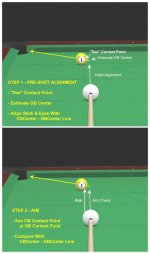I probably have the most stripped down aiming method there is - I just try to "feel" where the CB contact point is and aim it at the OB contact point (which I've trained myself to "see"). I like the simplicity and directness of this, but I've often thought that I could benefit from a little more structure and consistency in my (non-existent) pre-shot routine.
Lately I've been trying to adapt an idea that I like from the fractional aiming systems - using visible CB/OB landmarks as guides for a consistent pre-shot "starting alignment". Since I'm lucky enough to be able to "see" the OB contact point accurately (after years of practicing it), I'm using it as my "visible" OB landmark from which I estimate the ghostball center and line up on the CBcenter-to-GBcenter line.
I still "aim" one contact point at the other, but adding this pre-shot alignment routine (a hallmark of fractional systems) has helped me to get down consistently and quickly and has the added benefit of being a visual "cross-check" for aiming the CB contact point at the OB contact point. It has noticably improved my consistency, accuracy and (oddly enough), focus.
This is really simple, but here's a drawing for clarity anyway:

pj
chgo
Lately I've been trying to adapt an idea that I like from the fractional aiming systems - using visible CB/OB landmarks as guides for a consistent pre-shot "starting alignment". Since I'm lucky enough to be able to "see" the OB contact point accurately (after years of practicing it), I'm using it as my "visible" OB landmark from which I estimate the ghostball center and line up on the CBcenter-to-GBcenter line.
I still "aim" one contact point at the other, but adding this pre-shot alignment routine (a hallmark of fractional systems) has helped me to get down consistently and quickly and has the added benefit of being a visual "cross-check" for aiming the CB contact point at the OB contact point. It has noticably improved my consistency, accuracy and (oddly enough), focus.
This is really simple, but here's a drawing for clarity anyway:

pj
chgo